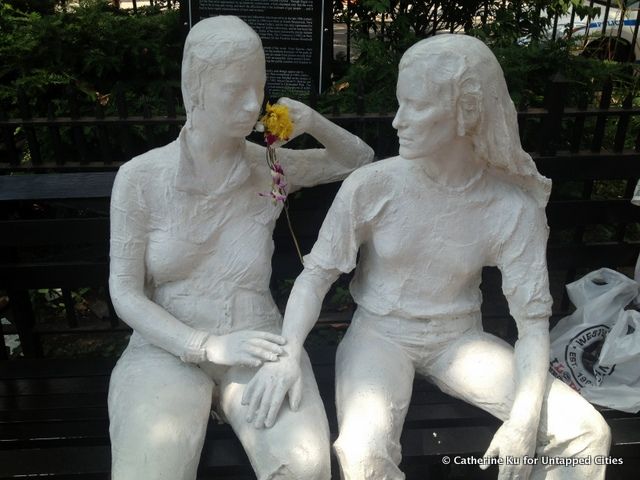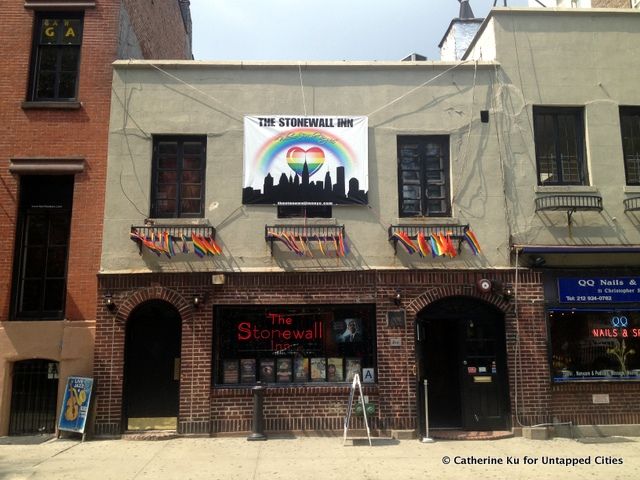Last Chance to Catch NYC's Holiday Notalgia Train
We met the voices of the NYC subway on our nostalgia ride this weekend!


The intersection of Christopher and Gay Streets, just down the street from Stonewall Inn.
Last week, thousands of visitors–gay and straight alike–descended on Christopher Street in celebration of gay pride. Amid the party atmosphere was also a sentiment of remembrance. After all, the Pride Parade is an annual continuation of the first Christopher Street Liberation Day in 1970, held in tribute of the infamous 1969 Stonewall Inn riots.
Fittingly, Christopher Street also intersects with Gay Street, one of the shortest streets in the city. But Gay Street’s name has nothing to do with the area’s gay history. It was, in fact, built to house stables for the horses of the wealthy families living on adjacent Waverly Place. Gay Street’s exact origins (the street was officially named in 1833) are unclear, but a May 11, 1775 article indicates a resident named R. Gay had a horse for sale in the area. Still, Gay Street became home to a number of speakeasies and artists in the early 20th century and by pure chance aptly describes its neighboring cousin Christopher Street.

Christopher Park, across the street from Stonewall, contains statues commemorating the street’s importance in gay history.
Before Christopher Street became synonymous with the gay rights movement, it was just another country lane. According to the Bowery Boys, it was the border of the pre-Revolution country estate of wealthy British seaman Sir Peter Warren. Two of Warren’s daughters married men whose names are became part of the NYC Street System: New York Supreme Court chief justice James DeLancey, from whom Delancey Street received its name and British colonel William Skinner. As an engagement present, Warren named the path at the edge of their estate “Skinner Road.” (There’s also a Warren Street that runs parallel to Chambers and Murray Streets.)
Bits and pieces of the Warren property were eventually sold off after the Revolution, and the land that contained Skinner Road was inherited in the late 1700s by Charles Christopher Amos, descendant of the trustee of the original Warren property. In keeping with Warren’s habit of naming things after himself, Amos parceled out his three names to various parts of his land: Amos Street (10th Street today), Charles Street and Christopher Street (renamed from Skinner Road).
In the 19th century, Greenwich Village was a melting pot of the bohemian and working-class of various ethnicities. The gay community was already established, but didn’t fully assert its presence until after World War II. Whereas the Village’s industry was once dominated by shipping, a decline in waterfront activity in the 1950s left the area’s taverns open for a different clientele.

Today’s Stonewall Inn only occupies half its original space at 53 Christopher.
Then came June 28, 1969, when the riots at Stonewall Inn (at 51-53 Christopher Street) cemented the street’s importance in the gay liberation movement. Many businesses closed as the gay community took a hit during the AIDS epidemic in the 1980s. In 1986, the Bailey-Holt House, which provides residential support to AIDS patients, opened at 180 Christopher. Just a few decades earlier, the space had housed the Hotel Christopher and popular gay bar Cockring (where there used to be chicken fights).
Today, Christopher Street has remained a fixture in the gay community. Take a walk down the street, and you can see what’s left of the dozens of bars that used to line the streets, some of which are still going strong. The original Stonewall Inn closed after the riots, but was reopened at 53 Christopher Street in 1990 and advertises itself as “where pride began.” Just around the corner on West 10th Street and Waverly Place is the city’s oldest gay bar, Julius’, in operation since 1864. On Hudson Street, between Christopher and West 10th, is the bar Employees Only.
Beyond the gay movement, the street was home to luminaries like poet e.e. cummings (number 11), philosopher Theodore Adorno (number 45) and Beatles wife Yoko Ono (number 87). Actor Philip Seymour Hoffman lives on nearby Sheridan Square. Today, property prices in the area are skyrocketing. One townhouse on adjacent Waverly Place was listed at $12 million. Despite the demand for space, one building stands noticeably empty. The Northern Dispensary, which once treated the poor and sick, has been the site of many development plans and deed squabbles.
Christopher Street has seen many transformations since its early days as a country lane and fancy wedding present. Reminders of its role in the gay liberation movement remain, and but the statues and rainbow flags only reveal part of the street’s intriguing past.
Get in touch with the author @catku. See more from our weekly column History of Streets.
Subscribe to our newsletter